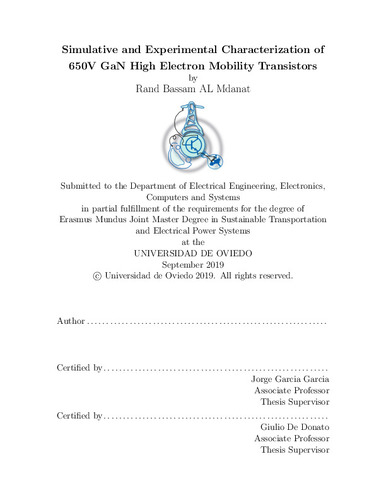Simulative and Experimental Characterization of 650V GaN High Electron Mobility Transistors
Autor(es) y otros:
Director(es):
Palabra(s) clave:
GaN Devices
Switching characteristics
Fecha de publicación:
Serie:
Máster Erasmus Mundus en Transporte Sostenible y Sistemas Eléctricos de Potencia
Descripción física:
Resumen:
The Gallium Nitride High Electron Mobility Transistors (GaN HEMT) based on field-effect transistors came out as new promising candidates for the high-frequency high-voltage applications, due to their unique capabilities of achieving higher current density, higher breakdown voltage, higher operating temperatures and higher frequencies compared to conventional silicon (Si) transistors. In this thesis, these novel transistors will be studied to understand their material properties and their main electrical characteristics. Then, a double pulse test will be carried out to study the switching behaviour of these transistors. Since the double pulse test is a practical method of characterizing the transient performance of semiconductors transistors under hard switching. The test will be performed experimentally and in simulation under different operating conditions to have the ability to understand the difference in the transistor behaviour under these different operating points. To do so, an evaluation kit from GaN Systems will be employed, as well as a Digital Signal Processor (DSP) of Texas Instruments. A PCB will be designed as an interface between the evaluation kit and the DSP to allow the control and the communication between them. While for the simulation, it will be implemented using LTSpice software, since GaN Systems provides an LTSpice model for their devices, which allows the evaluation of the device performance. Finally, the obtained results will be presented, commented and compared to identify the particularities of these devices.
The Gallium Nitride High Electron Mobility Transistors (GaN HEMT) based on field-effect transistors came out as new promising candidates for the high-frequency high-voltage applications, due to their unique capabilities of achieving higher current density, higher breakdown voltage, higher operating temperatures and higher frequencies compared to conventional silicon (Si) transistors. In this thesis, these novel transistors will be studied to understand their material properties and their main electrical characteristics. Then, a double pulse test will be carried out to study the switching behaviour of these transistors. Since the double pulse test is a practical method of characterizing the transient performance of semiconductors transistors under hard switching. The test will be performed experimentally and in simulation under different operating conditions to have the ability to understand the difference in the transistor behaviour under these different operating points. To do so, an evaluation kit from GaN Systems will be employed, as well as a Digital Signal Processor (DSP) of Texas Instruments. A PCB will be designed as an interface between the evaluation kit and the DSP to allow the control and the communication between them. While for the simulation, it will be implemented using LTSpice software, since GaN Systems provides an LTSpice model for their devices, which allows the evaluation of the device performance. Finally, the obtained results will be presented, commented and compared to identify the particularities of these devices.
Descripción:
chapter 1 introduces the motivation of the work, objectives and structure, Chapter 2 does a deep theoretical study of the main characteristics of the GaN high electron mobility transistors. The theoretical analyses will include the basics and main material properties of GaN devices and then compare them with other semiconductor materials. The basic structure of GaN transistors, its electrical characteristics and finally the gate driving constraints will be introduced as well. Later, a detailed explanation about the test carried out to study the switching characteristic of the GaN device is done in Chapter 3. The theoretical overview double pulse test will be explained, besides the test constraints and the measurement techniques that should be used to get the best results from this test. Moreover, the design main requirements will be addressed such as the experimental evaluation kit, the GaN transistor that had been used in the experimental test. After that, Chapter 4 will include the software design of the double pulse test circuit, which was done using LTSpice software, the second half of this chapter will discuss the implementation of the test setup. In this section, the design of the printed circuit board used in the setup will be explained in details, the method to generate the double pulse test signal using a microcontroller, and finally this section will show the complete setup of the test. In Chapter 5 the results of the experimental and stimulation tests will be presented, commented and compared, the test was done under different electrical parameters to be able to achieve a clear understanding of the device performance. The analysed voltages were: V$_{in}$ = 50V; 100V;150V; 200V; 250V; 250V. The analysed currents for each voltage level were: I = 5A; 10A; 15A; 20A; 25A; 30A, and this chapter will show some of these results. Moreover, anlayazing the switching losses using LTSpice software will be addressed in this chapter. Finally, Chapter 6 will include the conclusion of the project and the future work.
Colecciones
- Trabajos Fin de Máster [5292]
Ficheros en el ítem





